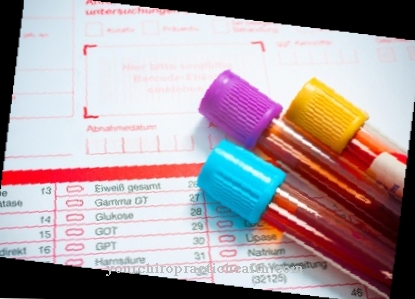Guanosine triphosphate As a nucleoside triphosphate, adenosine triphosphate is an important energy store in the organism. It mainly provides energy during anabolic processes. It also activates many biomolecules.
What is guanosine triphosphate?
Guanosine triphosphate (GTP) represents a nucleoside triphosphate, which is composed of the nucleotide base guanine, the sugar ribose and three phosphate residues linked to one another by anhydride bonds.
In this case, guanine is glycosidically bound to ribose and the ribose in turn is bonded to the triple phosphate residue via an esterification. The anhydride bond of the third phosphate group to the second phosphate group is very energetic. When this phosphate group is split off, GTP provides a lot of energy for certain reactions and signal transductions, as with the analogous compound adenosine triphosphate (ATP).GTP is formed either by simple phosphorylation from GDP (guanosine diphosphate) or by triple phosphorylation of guanosine.
The phosphate groups come from both ATP and transfer reactions within the citric acid cycle. The raw material guanosine is a nucleoside made from guanine and ribose. GTP is converted into GMP (guanosine monophosphate) by releasing two phosphate groups. As a nucleotide, this compound represents a building block of ribonucleic acid. When isolated outside the body, GTP is a colorless solid. In the body, it fulfills many functions as an energy transmitter and phosphate supplier.
Function, effect & tasks
In addition to the more well-known ATP, GTP is also responsible for many energy-transferring reactions. Many cellular metabolic reactions can only take place with the help of energy transfer through guanosine triphosphate.
As with ATP, the binding of the third phosphate residue to the second phosphate residue is very high in energy and comparable to its energy content. However, GTP catalyzes different metabolic pathways than ATP. GTP gets its energy from the breakdown of carbohydrates and fats within the citric acid cycle. An energy transfer from ATP to GDP with the transfer of a phosphate group is also possible. This creates ADP and GTP. Guanosine triphosphate activates many compounds and metabolic pathways. So it is responsible for activating G proteins. G proteins are proteins that can bind GTP.
This enables them to transmit signals via G-protein-associated receptors. These are signals for smelling, seeing or regulating blood pressure. GTP stimulates signal transduction within the cell by helping the transfer of important signal substances or by stimulating the G molecules with energy transfer initiating a signal cascade. Furthermore, protein biosynthesis cannot take place without GTP. The chain lengthening of the polypeptide chain takes place with the uptake of energy that is obtained from the conversion of GTP to GDP. The transport of many substances, including membrane proteins, to the membranes is also largely regulated by GTP.
GTP also regenerates ADP to ATP with the transfer of a phosphate residue. It also activates the sugars mannose and fucose, thereby forming ADP-mannose and ADP-fucose. Another important function of GTP is its participation in the construction of RNA and DNA. GTP is also essential for the transport of substances between the nucleus and the cytoplasm. It should also be mentioned that GTP is the starting material for the formation of cyclic GMP (cGMP).
The compound cGMP is a signaling molecule and is responsible, among other things, for visual signal transduction. It controls ion transport in the kidneys and intestines. It sends the signal for the blood vessels and bronchi to widen. After all, it is believed to be involved in the development of brain function.
Education, occurrence, properties & optimal values
Guanosine triphosphate occurs in all cells of the organism. It is indispensable as an energy store, phosphate group carrier and building block for the construction of nucleic acids. As part of the metabolism, it is made from guanosine, guanosine monophosphate (GMP) or guanosine diphosphate (GDP). GMP is a nucleotide of ribonucleic acid. It can also be recovered from this. However, a new synthesis in the organism is also possible.
The binding of further phosphate groups to the phosphate group esterified on the ribose is only possible with an expenditure of energy. The anhydride bond of the third phosphate group to the second in particular means a high expenditure of energy, because electrostatic repulsive forces build up which are distributed over the entire molecule. Tensions develop within the molecule, which upon contact with the corresponding target molecule are transferred to the latter, releasing a phosphate group. Conformational changes occur in the target molecule, which trigger the corresponding reactions or signals.
Diseases & Disorders
If the signal transmission does not take place properly in the cell, a variety of diseases can result. In connection with the function of GTP, the G proteins are of great importance for signal transport.
G proteins represent a heterogeneous group of proteins that can transmit signals by binding to GTP. A signal cascade is triggered, which is also responsible for the fact that neurotransmitters and hormones become effective by docking on G-protein-associated receptors. Mutations in G proteins or their associated receptors often disrupt signal transmission and are the cause of certain diseases. For example, fibrous dysplasia or Albrigh bone dystrophy (pseudohypoparathyroidism) is triggered by the mutation of a G protein. This disease is resistant to parathyroid hormone.
That is, the body does not respond to this hormone. Parathyroid hormone is responsible for calcium metabolism and bone formation. The bone structure disorder leads to myxomas of the skeletal muscles or dysfunction of the heart, pancreas, liver and thyroid gland. In acromegaly, on the other hand, there is a resistance to growth hormone releasing hormone, so that the growth hormone is released in an uncontrolled manner and thus causes increased growth of limbs and internal organs.


.jpg)



.jpg)




















